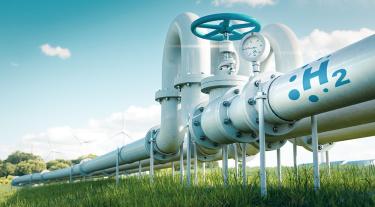There are several factors which contribute to this complexity and hinder hydrogen’s deployment. Some off the less well-documented ones include:
- The lack of a whole systems view – A future energy system needs to make use of both hydrogen and electricity – not one or the other. This mean a holistic view will be key. For example, electrification could be more efficient for fleet vehicles with high utilisation rates, but using hydrogen would cut refuelling times and avoid battery weight. These factors may mean fleet owners choose hydrogen vehicles over electric.
- Environmental impacts – Hydrogen has a global warming potential greater than initially thought. As an indirect greenhouse gas (GHG) it interacts with other GHGs in the atmosphere and enhances their effects. Avoiding leakage along the supply chain, to ensure it doesn’t increase environmental impacts, will be crucial.
- Biased and unreliable information – There are many different opinions in the hydrogen sector. This range of views, combined with a lack of objective evidence, can harm the confidence of decision makers, including investors, when making big commitments. To develop hydrogen as a clean energy solution the sector needs more impartial, objective evidence, from trusted sources.
- Policy and regulation – The current lack of regulatory frameworks for hydrogen makes it challenging for commercial projects to understand future costs and revenue. Hydrogen spans many siloed regulatory environments, including gas, electricity, and water. Currently there’s no clear view on how they align with hydrogen. As a result, encouraging private sector investment can be difficult. Whilst the UK has some policy support in place targeted at hydrogen innovation and deployment, more is needed to inspire confidence and attract inward investment.
In addition to the above, there are more painfully familiar barriers, including:
- High end-to-end costs – Although hydrogen has continued to rise up the energy sector’s agenda, prohibitively high end-to-end costs have knocked it back down. Net Zero legislation makes clean hydrogen’s role in decarbonisation unavoidable, but cost is still an issue. However, recent subsidies and less stringent policy requirements from the US and EU governments, combined with high natural gas prices, have helped lower prices. For the UK to remain attractive to investors, the government will need to explore similar support mechanisms.
- Lack of market – The introduction of appropriate business models will play a crucial role stimulating and structuring the market. This started to happen in April 2022 when the UK’s Department for Business, Energy and Industrial Strategy (BEIS) published an indicative Heads of Terms for a low carbon hydrogen business model, providing the sector with some much-needed clarity on the expected payment mechanism. Needed next are mechanisms for hydrogen commoditisation which benefit developers, investors, and other sectoral stakeholders. Once the benefit becomes evident, there should be increased market interaction. Internationally, other countries are looking at mechanisms to support market growth too. For example, Germany and Australia’s governments partnered up to deliver a joint feasibility study. As a result of the HySupply project, Germany and Australia will start to identify opportunities to match up supply and demand between the two countries, and consequently stimulate demand.
- Incomplete hydrogen infrastructure – Unlike with electricity and natural gas, there is no existing ecosystem for hydrogen storage and distribution. This means the whole value chain must scale simultaneously to overcome the ‘chicken-and-egg’ dilemma. Unprecedented levels of collaboration and coordination, underpinned by clarity and ambition, are required to coordinate hydrogen supply and demand, and create a supporting infrastructure.
- Safety concerns – Hydrogen is highly flammable, which means that safety cases have to be made for its use in different applications, particularly for domestic applications. Hydrogen’s small size allows it to leak through our existing gas infrastructure which contributes to concerns. The good news is this infrastructure is being upgraded from steel to hydrogen-ready PVC.
Whilst most of the barriers listed above are commercial and social, there are technical barriers associated with hydrogen’s low efficiencies across the value chain. There are no silver bullets as no solution is perfect for all scenarios – hydrogen included. To reach Net Zero quickly and affordably, we need a portfolio of options to deliver clean energy where it is needed, when it is needed. This makes finding the right role for each solution and identifying innovation required make each a viable reality. The UK Government’s long-awaited Hydrogen Strategy, announced in August 2021, goes someway to addressing this, but a wide range of stakeholders and more open innovation is required.
Our vision for the sector is: the deployment of hydrogen, underpinned by a whole systems approach, for a cost-effective Net Zero transition. As part of our Hydrogen Accelerator, we have been working to understand our role in facilitating innovation and addressing barriers. We are working with experts across academia, hydrogen production, local government end-users. Throughout every stage, our approach has been to collaborate, understand the issues, then co-create solutions which benefit the hydrogen sector and wider energy system.
In our next and final piece, we’ll share what we have designed to help industry overcome the above barriers. In the meantime, if you are a hydrogen innovator, project developer, or investor with questions on the sector or ideas for accelerating it, please get in touch.



